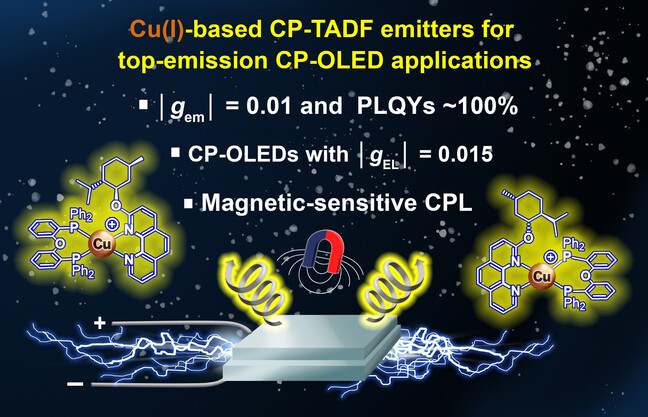В журнале Angewandte Chemie International Edition (IF 16,1) опубликована статья, соавторами которой являются ученые из ИНХ СО РАН, Китая и НИОХ СО РАН (к.х.н. А. М. Агафонцев (снс ЛТС), д.х.н. И.Ю. Багрянская (внс, руководитель группы ГРСА) и д.х.н., проф. А.В. Ткачев (завлаб ЛТС) :
Outstanding Circularly Polarized TADF in Chiral Cu(I) Emitters: From Design to Application in CP-TADF OLEDs
Maxim Yu. Petyuk, Lingqiang Meng, Zihao Ma, Alexander M. Agafontsev, Irina Yu. Bagryanskaya, Alexey Berezin, Jingzhi Zhang, Anlea Chu, Mariana I. Rakhmanova, Hong Meng, Alexey V. Tkachev, Vivian Wing-Wah Yam, Alexander V. Artem'ev
Angewandte Chemie International Edition, V. 63, N 52, December 20, 2024, e202412437
First published on 04 Sept 2024
Graphical Abstract
Chiral Cu(I) emitters exhibiting circularly polarized thermally activated delayed fluorescence (CP-TADF) with a record-high quantum yield (close to 100 %) and high dissymmetry factor (|glum|~1×10−2) have been developed. Based on these emitters, efficient CP-TADF OLEDs with high |gEL| factors of 1.5×10−2 were fabricated. It was also discovered that a magnetic field significantly suppresses the CP-TADF of chiral Cu(I) emitters.
Abstract
Low-cost molecular emitters that merge circularly polarized luminescence (CPL) and thermally activated delayed fluorescence (TADF) properties are attractive for many high-tech applications. However, the design of such emitters remains a difficult task. To address this challenge, here, we propose a simple and efficient strategy, demonstrated by the design of pseudochiral-at-metal complexes [Cu(L*)DPEPhos]PF6 bearing a (+)/(–)-menthol-derived 1,10-phenanthroline ligand (L*). These complexes exhibit a yellow CP-TADF with a record-high quantum yield (close to 100%) and high dissymmetry factor (|glum| ~ 1×10–2). Remarkably, the above compounds also show a negative thermal-quenching (NTQ) of luminescence in the 300–77 K range. Exploiting the designed Cu(I) emitters, we fabricated efficient CP-TADF OLEDs displaying mirror-imaged CPL bands with high |gEL| factors of 1.5×10–2 and the maximum EQE of 6.15%. Equally important, using the (+)-[Cu(L*)DPEPhos]PF6 complex, we have discovered that an external magnetic field noticeably suppresses CP-TADF of Cu(I) emitters. These findings are an important contribution to the CPL phenomenon and provide access to highly efficient, low-cost and robust CP-TADF emitters.


